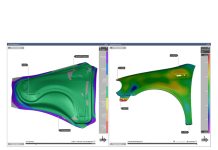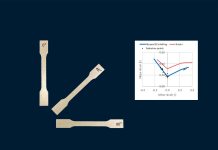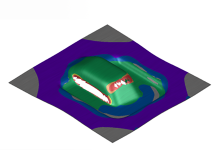Setting the Record Straight on Accuracy in Japan
An Interview with Bart Carleer PhD Corporate Technical Director
Following our last post on ‘85% Accuracy Rate Realised in First Tryouts‘ this blog post continues to publish our never before seen Japanese articles. –
When AutoForm entered the market in 1995, it was nothing less than revolutionary. Its software allowed customers to perform sheet metal forming simulations in a fraction of the previously possible time. As a result, AutoForm earned a reputation for speed, especially where verification processes for avoiding splits and wrinkles were concerned.

“The point is that, 20 years ago, it was unbelievable how fast AutoForm could generate a result,” says Bart Carleer, corporate technical director, AutoForm Engineering GmbH, who we’ve interviewed. The software’s fast results accelerated the trial and error process, thanks to elements in the software such as the bending-enhanced membrane, which quickly and accurately describes or predicts splits and wrinkles, but was less suitable for other results such as springback.
Despite AutoForm’s introduction about 10 years ago of the Elastic Plastic Shell, which could accurately predict springback, an unfortunate image was created in the minds of some in the industry that AutoForm’s speed came at the expense of accuracy.
Fortunately, certain test, reviews and case studies has changed those opinions and this blog post throws light on the matter once and for all.
Getting it Right – Third Party Reviews
“From an image point of view, our competitors are always very pleased to refer to the old days, where we looked more into concept evaluation. They are making use of our old starting point, but we have been improving for 20 years. This old image is not at all valid anymore,” Carleer says.
“If you look at the NUMISHEET benchmarks over the past 10 years, you will see we are at least as accurate as all other programs, so there is really no issue with respect to accuracy, and in many cases with respect to springback. The good thing about NUMISHEET is that it is a blind test. You set up, you simulate, and you have to send in the results. We have never been reluctant to do so, because we were convinced that our software could do it without problem. We have always shown that we are as accurate as all the rest, and often with shorter computation times. NUMISHEET is generally focusing on final validation, which we believe shows we are as accurate as all the others,” says Carleer.

Material Models and Accuracy
In other words, AutoForm continues to be the industry leader in speed, and has long since caught up where accuracy is concerned. “We are making use of algorithms, numerics, and we all have assumptions,” says Carleer. “The assumptions we make are different sometimes than those of our competitors. I think everyone can point to five examples out of 100 where they are more accurate than the competition, and focus on those. But with respect to computation time, we are still faster than the competition, and at least as accurate, on the whole.”
User Friendly
Like all good tools, AutoForm isn’t merely of use – it is in fact easy to use. “Results with AutoForm,” says Carleer, “are less user-dependent. It is not a test of the expertise of the user who is applying the program, but of the program itself, our user guidance, our default settings.
“The source of errors is very limited,” he says, “so I would almost say that it is quite easy to get accurate results if you follow some easy guidelines from us. With other programs, there is more variation in the results.”
Carleer cites AutoForm’s philosophy of producing easy-to-use software that does not require intimate knowledge of the math behind the scenes. “Just think like an engineer who wants to solve a sheet-metal forming process,” he advises.
Carleer compares AutoForm’s software interface to that of a car, as opposed to that of an airplane. “I step into a car, switch on the engine, and check a few boundary conditions. If it’s dark, I switch on the light. If it’s raining, I switch on the wipers. And then off I go,” he says, whereas the pilot of a plane has to spend time checking the intimate details of all systems before he can even start the engine.
“So we want to have an easy-to-use cockpit. You check a few essential issues, and then off you go, driving towards your target. There is no checklist of 20 minutes doing this and that. Because everything you need to check and define is a source for a possible mistake. If you have to make 100 little decisions, yes, no, green, white, etc., then the chance that you forget something or make some small mistake goes up. In that sense, the less you have to do, the more you can work with our validated default settings, the better your results will be.” The upshot of this way of working, for engineers, is a considerable amount of time saved.

When a user is in the early stages of design, he can use the concept evaluation strategy in conjunction with the bending-enhanced membrane to sort out splits and wrinkles. Then, with the “push” of an on-screen button, validation mode is engaged to sort out springback, surface defects, and other late-stage issues.
“As I said, if it’s raining, you switch on the wipers to see better. These are the little things users have to think of, but it is easy to use, uncomplicated. I push one button and the wipers go on. I push one button, I have my final validation settings and I can do springback. This is very important to us, and I believe it has real value,” says Carleer, adding that the user-friendly interface is backed up by employees, real people on the ground in various markets around the world who are up-to-date with the changing needs of the customers and the market.
“In that sense, we bring value not only through the software itself as a tool, but through support, through a local team being there to do the fine tuning on the customer side,” he says.
Open Dialogue with Japanese Customers
Japan, Carleer says, presents an interesting difference from the world’s other major markets. “In Europe and the U.S., design was given and the engineers had to solve the manufacturing problems to get the design. The design always led the process. It was a challenge for them to look into splits and wrinkles and find a suitable process, and for that, AutoForm and its concept evaluation settings was perfect.
“In Japan, the philosophy was focused more on manufacturing; they were willing to adapt the design to have better manufacturability. In that sense the focus was on looking for accuracy issues beforehand, and of course, 15 years ago we were focused on other things. Now, we want to let the Japanese market know that our accuracy credentials are tried and true,” says Carleer.
AutoForm recognizes that, to update its image in the market, it needs to open up and communicate. “I have to be honest, 10 years ago you did not find any publication about the AutoForm code or software program, because we were too busy developing and servicing our customers. But we have changed a lot since then,” he says, and indeed AutoForm has had a high profile at international conferences and in magazines in recent years.
To stay informed about other interesting articles don’t forget to sign up to this blog!
You may also like this blog post:
Worst Case Material Not the Best Option.













